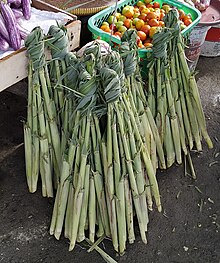
Eggplant, aubergine, brinjal, or baigan (GY) is a plant species in the nightshade family Solanaceae. Solanum melongena is grown worldwide for its edible fruit.
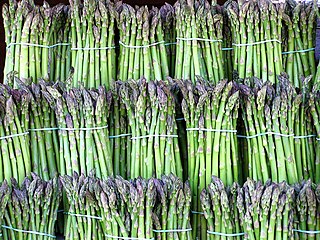
Asparagus, or garden asparagus, folk name sparrow grass, scientific name Asparagus officinalis, is a perennial flowering plant species in the genus Asparagus. Its young shoots are used as a spring vegetable.
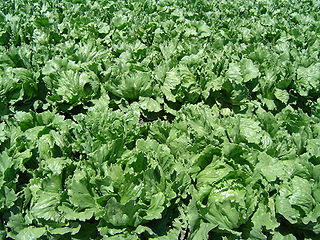
Lettuce is an annual plant of the family Asteraceae. It is most often grown as a leaf vegetable, but sometimes for its stem and seeds. Lettuce is most often used for salads, although it is also seen in other kinds of food, such as soups, sandwiches and wraps; it can also be grilled. One variety, celtuce, is grown for its stems, which are eaten either raw or cooked. In addition to its main use as a leafy green, it has also gathered religious and medicinal significance over centuries of human consumption. Europe and North America originally dominated the market for lettuce, but by the late 20th century the consumption of lettuce had spread throughout the world. As of 2021, world production of lettuce and chicory was 27 million tonnes, 53 percent of which came from China.

Momordica charantia is a tropical and subtropical vine of the family Cucurbitaceae, widely grown in Asia, Africa, and the Caribbean for its edible fruit. Its many varieties differ substantially in the shape and bitterness of the fruit.

Tragopogon porrifolius is a plant cultivated for its ornamental flower and edible root. It also grows wild in many places and is one of the most widely known species of the salsify genus, Tragopogon. It is commonly known as purple or common salsify, oyster plant, vegetable oyster, Jerusalem star, Jack go to bed, or simply salsify.

Chayote, also known as mirliton and choko, is an edible plant belonging to the gourd family, Cucurbitaceae. This fruit was first cultivated in Mesoamerica between southern Mexico and Honduras, with the most genetic diversity available in both Mexico and Guatemala. It is one of several foods introduced to the Old World during the Columbian Exchange. At that time, the plant spread to other parts of the Americas, ultimately causing it to be integrated into the cuisine of many Latin American nations.

The winged bean, also known as cigarillas, goa bean, four-angled bean, four-cornered bean, manila bean, princess bean, asparagus pea, dragon bean, is a tropical herbaceous legume plant.

The asparagus bean is a legume cultivated for its edible green pods containing immature seeds, like the green bean. It is also known as: yardlong bean, pea bean, long-podded cowpea, Chinese long bean, snake bean, bodi, and bora. Despite the common name of "yardlong", the pods are actually only about half a yard long, so the subspecies name sesquipedalis is a more accurate approximation.

Leaf vegetables, also called leafy greens, pot herbs, vegetable greens, or simply greens, are plant leaves eaten as a vegetable, sometimes accompanied by tender petioles and shoots. Leaf vegetables eaten raw in a salad can be called salad greens.

Taro is a root vegetable. It is the most widely cultivated species of several plants in the family Araceae that are used as vegetables for their corms, leaves, stems and petioles. Taro corms are a food staple in African, Oceanic, East Asian, Southeast Asian and South Asian cultures. Taro is believed to be one of the earliest cultivated plants.

Parkia speciosa, the bitter bean, twisted cluster bean, sator bean, or stink bean, is a plant of the genus Parkia in the family Fabaceae. It bears long, flat edible beans with bright green seeds the size and shape of plump almonds which have a rather peculiar smell, similar to, but stronger than that of the shiitake mushroom, due to sulfur-containing compounds also found in shiitake, truffles and cabbage.
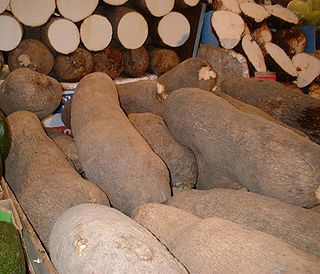
Yam is the common name for some plant species in the genus Dioscorea that form edible tubers. The tubers of some other species in the genus, such as D. communis, are toxic. Yams are perennial herbaceous vines cultivated for the consumption of their starchy tubers in many temperate and tropical regions, especially in West Africa, South America and the Caribbean, Asia, and Oceania. The tubers themselves, also called "yams", come in a variety of forms owing to numerous cultivars and related species.

Pleiogynium timoriense, commonly known as the Burdekin plum, sweet plum, tulip plum, or in the Djabugay language guybalum is a medium-sized fruit-bearing tree in the family Anacardiaceae native to Malesia, Australia and the Pacific Islands.

Sugarcane or sugar cane is a species of tall, perennial grass that is used for sugar production. The plants are 2–6 m (6–20 ft) tall with stout, jointed, fibrous stalks that are rich in sucrose, which accumulates in the stalk internodes. Sugarcanes belong to the grass family, Poaceae, an economically important flowering plant family that includes maize, wheat, rice, and sorghum, and many forage crops. It is native to the warm temperate and tropical regions of India, Southeast Asia, and New Guinea. Grown in tropical and subtropical regions, sugarcane is the world's largest crop by production quantity, totaling 1.9 billion tonnes in 2020, with Brazil accounting for 40% of the world total. Sugarcane accounts for 79% of sugar produced globally. About 70% of the sugar produced comes from Saccharum officinarum and its hybrids. All sugarcane species can interbreed, and the major commercial cultivars are complex hybrids.
Eumetopina flavipes, the island sugarcane planthopper, is a species of planthopper present throughout South East Asia. E. flavipes is a vector for Ramu stunt disease, a plant disease which affects sugarcane. Ramu stunt disease is widespread throughout Papua New Guinea, but has not been detected in Australia.

Fijian cuisine has long-consisted of primarily foraged and farm-grown food. Although rice, wheat, and tea all became staples during Fiji's colonial era, native Fijians still eat primarily tubers and coconuts. The cuisine of Fiji is known for its seafood and various green vegetables, including ''ota'', a young forest fern, and ''bele'', a plant that resembles spinach.
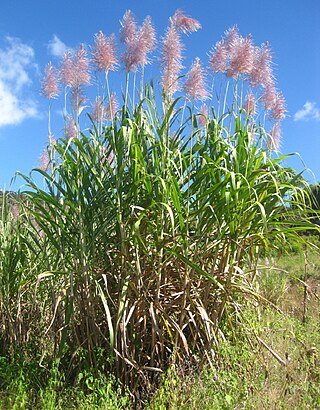
Saccharum officinarum is a large, strong-growing species of grass in the sugarcane genus. Its stout stalks are rich in sucrose, a simple sugar which accumulates in the stalk internodes. It originated in New Guinea, and is now cultivated in tropical and subtropical countries worldwide for the production of sugar, ethanol and other products.

Setaria palmifolia is a species of grass known by the common names palmgrass, highland pitpit, hailans pitpit, short pitpit, broadleaved bristlegrass, and knotroot. In Spanish it is called pasto de palma and in Samoan vao 'ofe 'ofe. It is native to temperate and tropical Asia. It is known elsewhere as an introduced, and often invasive, species, including in Australia, New Zealand, many Pacific Islands, and the Americas.

Aniseia martinicensis is a species of herb climber in the Convolvulaceae family. Native to subtropical and tropical America, it has been introduced to the tropics and sub-tropics of the Pacific Islands, Australia, Asia, and Africa. It is usually eaten as a supplementary vegetable. Even though it grows around the world, in a variety of habitats, it is a rare plant.

Asparagus africanus, also known as African asparagus, bush asparagus, wild asparagus, climbing asparagus fern, ornamental asparagus and sparrow grass, is an African species of plant that is found in a variety of habitats. It has multiple medicinal properties and is used to treat various ailments.
